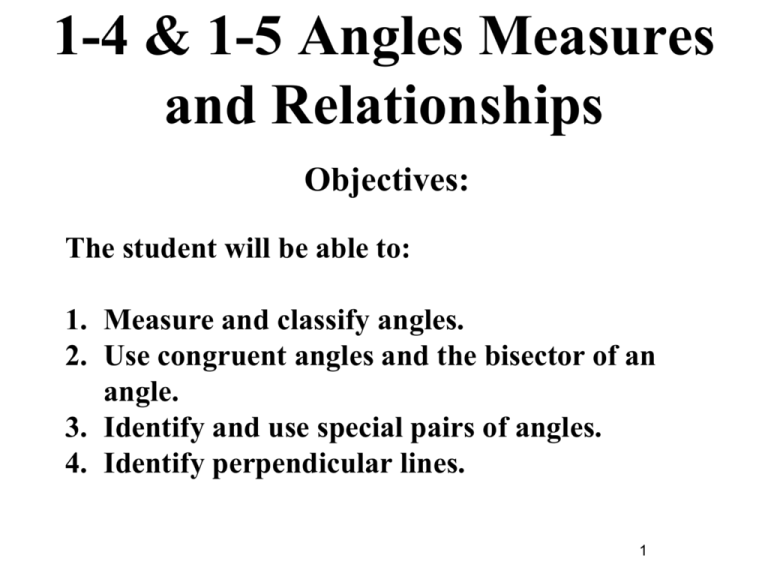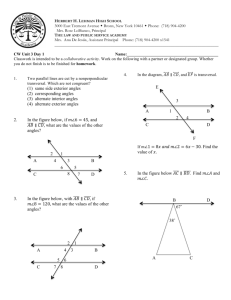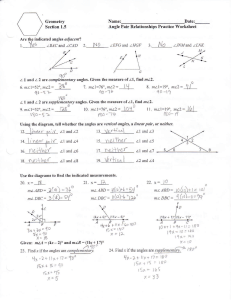Congruent Angles - Bartlett High School
advertisement

1-4 & 1-5 Angles Measures and Relationships Objectives: The student will be able to: 1. Measure and classify angles. 2. Use congruent angles and the bisector of an angle. 3. Identify and use special pairs of angles. 4. Identify perpendicular lines. 1 Classifying Angles Acute Angles < 90° Naming Angles: Right Angles = 90° Obtuse Angles > 90° When naming angles using 3 letters, the vertex must be the second of the 3 letters. You can name an angle using a single letter only when there is exactly one angle located at the vertex. Naming angles. 3 Congruent Angles & Angle Bisector: A ray that divides an angle into two congruent angles. PQS ≅ TQS The bisector of PQT is QS . In the figure, QS is the angle bisector of ÐPQT . Point S lies in the interior of ÐPQT and ÐPQS = ÐTQS . If mÐPQT = 50 and mÐPQS = 4x +14 , find the value of x. ÐPQS = ÐTQS 50 = 4x + 14 -14 -14 36 = 4x 9 = x Example: In the figure, QS is the angle bisector of ÐPQT . Point S lies in the interior of ÐPQT and ÐPQS = ÐTQS . If mÐTQS = 6x - 2 and mÐPQS = 3x +13, find the value ofÐPQT . ÐTQS = ÐPQS 6x - 2 = 3x + 13 -3x +2 3x = 15 x = 5 Did we answer the question? NO! If mÐTQS = 6x - 2 and mÐPQS = 3x +13 , find the value of ÐPQT . PQS TQS PQT 6(5) – 2 + 3(5) + 13 = PQT 30 – 2 + 15 + 13 = PQT 56° = PQT Special Angle pairs 1 2 3 4 5 6 7 8 Adjacent Angles: Two angles that lie in the same plane and have a common vertex and a common side, but no common interior points. 1 & 2, 1 & 3, 2 & 4, 3 & 4, 5 & 6, 5 & 7, 6 & 8, 7 & 8 Vertical Angles: Two angles that are opposite angles. Vertical angles are congruent. 1 4, 2 3, 5 8, 6 7 Linear Pair: Supplementary angles that form a line (sum = 180) 1 & 2 , 2 & 4 , 4 &3, 3 & 1, 5 & 6, 6 & 8, 8 & 7, 7 & 5 Special Angle pairs E Congruent Angles: Two or more angles that have the same measure. AEB & BEC, CED & DEA, AEB & DEC, BEC & AED Perpendicular angles: Lines, segments, and rays that form right angles (90 degrees). AEC & BED Complementary & Supplementary Angles Complementary Angles: Two angles whose measures have a sum of 90°. A + B = 30 + 60 = 90 Supplementary Angles: Two angles whose measures have a sum of 180°. F + G = 120 + 60 = 180 Identify: Two Obtuse vertical angles: Two acute adjacent angles: An angle supplementary to TNU: Find x so that DZ ^ PZ. If the two angles are perpendicular they MUST = 90° . (9x + 5) + (3x + 1) = 90 12x + 6 -6 = 90 -6 12x = 84 x=7 Example: Find the measures of 2 supplementary angles if the difference in their measures is 18. 1 2 = 180 x + (x – 18) = 180 2x – 18 = 180 +18 +18 2x = 198 x = 99 Are we through? NO!! If x = 99, what are the measures of the supplementary angles? Ð2 = 99 -18 = 81 Ð1= 99 How can I check to see if that’s correct? 99 + 81 = 180 Find x and y so that KO and HM are perpendicular. 1. Find x by setting the two angles equal to 90. 2. Vertical angels tell us if ÐKJI +ÐIJH =90, then ÐMJO=90. 3. Find y by setting ÐMJO=90. ÐKJI +ÐIJH = 90 (3x + 6) + (9x) = 90 12x + 6 -6 12x = 90 -6 = 84 x=7 ÐMJO=90 (3y + 6) = 90 - 6 -6 3y = 84 y = 28 1. Are the angles congruent? Yes – set the expressions equal to each other. A=B 2. Do the angles add up to 90°? Yes – add the expressions and set them equal to 90°. A + B = 90 3. Do the angles add up to 180°? Yes – add the expressions and set them equal to 180°. A + B = 180 4. Do the angles add up to some other value given in the problem? Yes – add the expressions and set them equal to the value. A + B = other value







